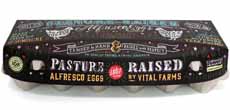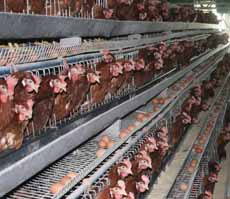Eggs Glossary: A Glossary Of The Different Eggs TypesPage 1: Glossary Terms A To D This is Page 1 of an 4-page article. Click on the red links below to visit other pages. This glossary is protected by copyright and cannot be reproduced in whole or part. You are welcome to link to it. CAPSULE REPORT: The eggs of birds and reptiles (think turtle eggs) have been gathered for food since the dawn of man—and enjoyed by other animals since, well, the dawn of eggs. The most commonly-raised are chicken eggs; duck, goose, ostrich and quail eggs are used as gourmet ingredients; pheasant eggs and emu eggs can sometimes be found. But the ubiquitous chicken egg holds center stage in our egg glossary. This is Page 1 of a four-page article about chicken eggs. Click on the black links below to visit other pages. Eggs are an inexpensive source of protein, a versatile ingredient and an essential component of foods we hold dear, from omelets to cakes and cookies. Just a few years ago, you had a choice of white or brown eggs. (White eggs come from white hen varieties, brown eggs come frombrown-feathered hens, and are a bit more expensive because brown hens tend to be larger and consume more feed.)
|
 These eggs were gathered from different heritage breeds of chickens. These are the natural colors of the shells: The eggs are not dyed, and no color enhancements have been made to this photo. Photo by Hudson Bedell | IST. |
|
|
Today, there are 10 choices to be made in chicken eggs alone. In addition to the regular brown and white eggs of yore, here are eight additional choices—most of which are available in brown or white as well. We also briefly address the other types of eggs that can be found in specialty food stores, on restaurant menus, and the websites of breeders who make them available to consumers nationwide. ALBUMEN: |
 Albumen, or egg white. Photo courtesy Pritikin.com. |
|
| ANTIBIOTIC-FREE EGGS: Eggs contain no antibiotic residue, even if the hen has been given antibiotics. However, if she has had antibiotics, the eggs cannot be labeled anti-biotic free, even though they contain no antibiotics. Egg laying hens are not given hormones, so all eggs are hormone-free. |
||
| ARACAUNA EGGS: Aracauna eggs are from Aracauna chickens, native to South America. Nutritionally, these bluish-green eggs are not much different fro traditional white and brown eggs. Although some people think aracauna eggs are lower in cholesterol, eggs from this breed have a higher cholesterol content. While eggs in the U.S. come from cost-effective breeds that yield white or brown eggs, some non-commercial breeders have heritage breeds that yield beautiful colors, like the aracauna. For example, Penedesencas from Spain lay eggs that are a very dark, reddish brown.” Cuckoo Marans and Welsummers lay speckled eggs. Some Eggers lay pale green and olive. All in all, there’s a rainbow of options. |
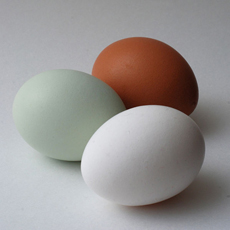 The pale blue-green Aracauna egg, along with traditional white and brown varieties. Photo by Gmoose1 |Wikimedia. |
|
| CAGE-FREE EGGS: Cage-free and free-range chicken eggs appeal to people who object to caging animals; however, the cage-free system does not necessary provide optimal safety to the hens. The “free” hens can be very crowded on a henhouse floor, and injury can result. Instead, better standards may come from a United Egg Producers Certified Egg. Cage free is also known as free roaming. |
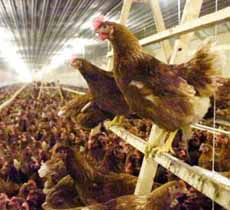 Cage free is not necessarily a good thing. Photo courtesy Fox News. |
|
| CERTIFIED HUMANE: Certified by Humane Farm Animal Care (HFAC), the leading non-profit certification organization dedicated to improving the lives of farm animals in food production from birth through slaughter. CERTIFIED ORGANIC: CHALAZAE CORDS: COMMERCIAL EGGS:
|
 Certified Humane logo.
|
|
| DUCK EGGS: Duck eggs look like chicken eggs, but are larger: As with chicken eggs, they are sold in sizes ranging from small to jumbo. The egg white is more transparent, without the yellowish tinge of a chicken’s white. Duck eggs have more protein and more flavor/richness than chicken eggs, but they also have a higher fat content and more cholesterol. When boiled, the white turns bluish and the yolk turns red-orange. See a full nutritional comparison of chicken and duck eggs. Continue To Page 2: Egg Terms E To G Go To The Article Index Above |
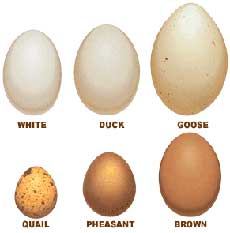 A comparison of some of the different types of eggs. Chart courtesy VictoriaPacking.com. |
|
Last Updated May 2018
© Copyright 2005-2025 Lifestyle Direct, Inc. All rights reserved. All images are copyrighted to their respective owners.
